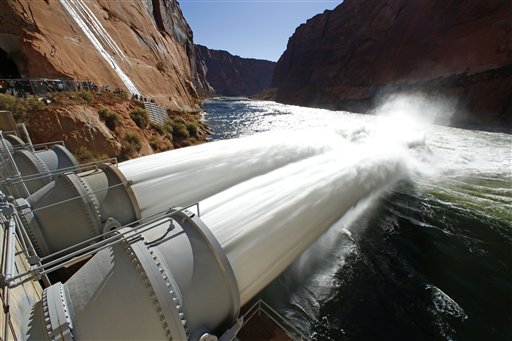A manmade flood through the Colorado River last fall created sandbars as intended, but scientists say the real test of success will be in whether the sandbars can be sustained over a long period of time.
Of the 33 sandbars monitored by cameras, 18 had substantial gains, 12 had no significant change and three decreased in size, said USGS research hydrologist Paul Grams. On-site assessments are scheduled for later this year.
The heavy rush of water from Glen Canyon Dam over 24 hours in November was part of a government program to restore the Grand Canyon’s ecosystem by washing millions of tons of sediment downstream to create beaches and improve habitat for plants and animals, and protect archaeological sites.
Previous experiments in 1996, 2004 and 2008 were one-time fact-finding missions instead of fundamental shifts in river management. Those, too, had mixed results.
“It’s a question of whether you can have the erosion between them be slow enough so it doesn’t go back completely to where you started before you have another flood,” Grams said.
Since the 1960s, Glen Canyon Dam in Page has blocked 90 percent of the sediment from the river from flowing downstream, turning the once muddy and warm river into a cool, clear environment that helped speed the spread of extinction of fish species and pushed others near the edge. It also has affected hydroelectricity, beach recreation and archaeological sites.
The high-flow experiments are timed to take advantage of sediment deposit from the Paria River, about 16 miles downstream from Glen Canyon Dam. USGS research hydrologist David Topping said sediment from the river was reasonably large last year but the concentration of sand in Marble Canyon was lower than during the 2004 and 2008 floods.
John Weisheit, conservation director for the Moab, Utah-based conservation group Living Rivers, said he’d like to see sand brought in from elsewhere to prevent sandbars from eroding or have the dam decommissioned. While beaches for campers and habitat temporarily improve, “the long-term prognosis for the Grand Canyon is a system without sediment,” he said.
The U.S. Bureau of Reclamation has said it could cost more than $100 million to build a pipeline to deliver the same amount of sand that the Paria dumps in the canyon. The U.S. Geological Survey said sand depletion hasn’t yet wiped out gains from the floods but eventually could, the Arizona Republic reported.
Members of the Colorado River Energy Distributors Association lost about $1.4 million in power generation during the flood, executive director Leslie James estimated.




